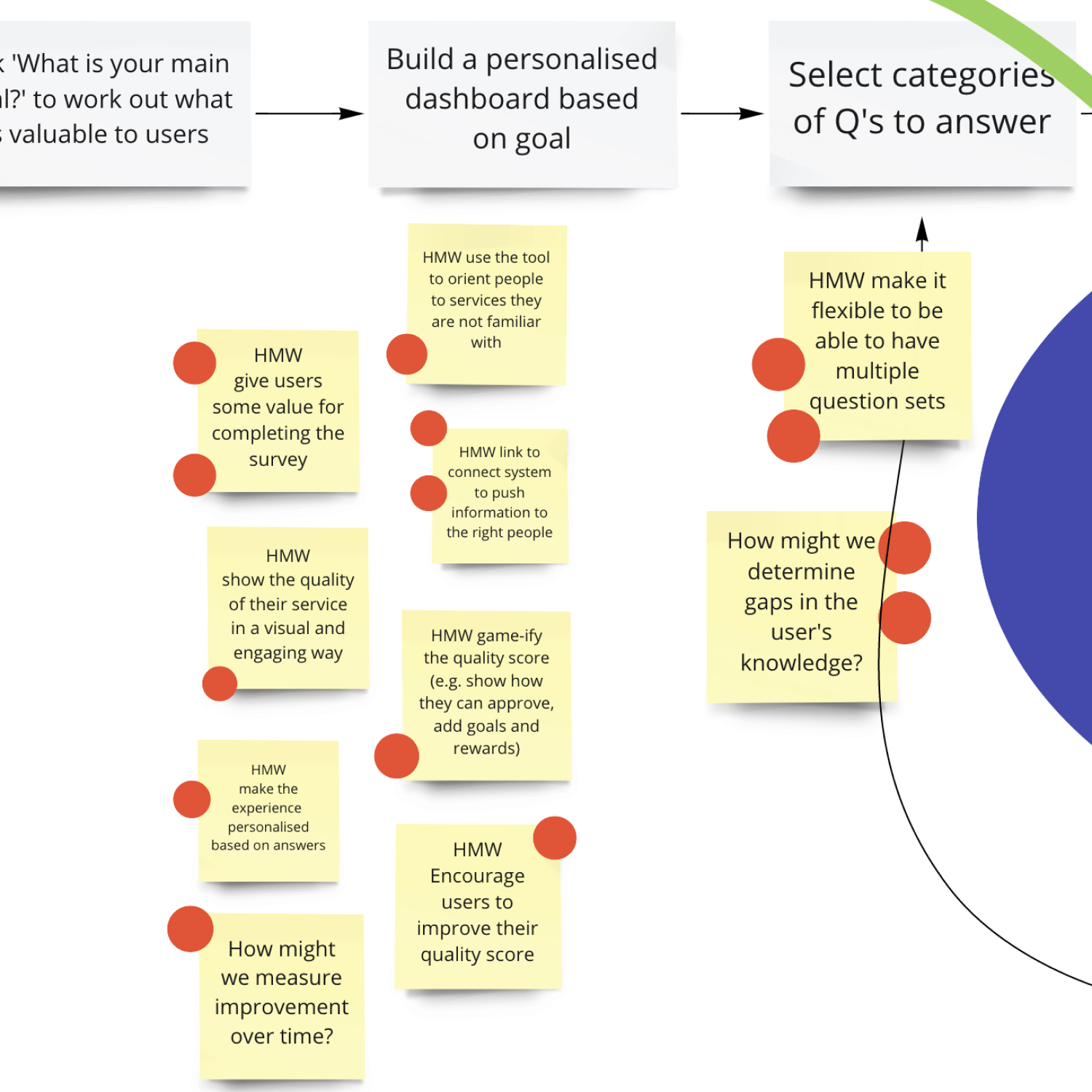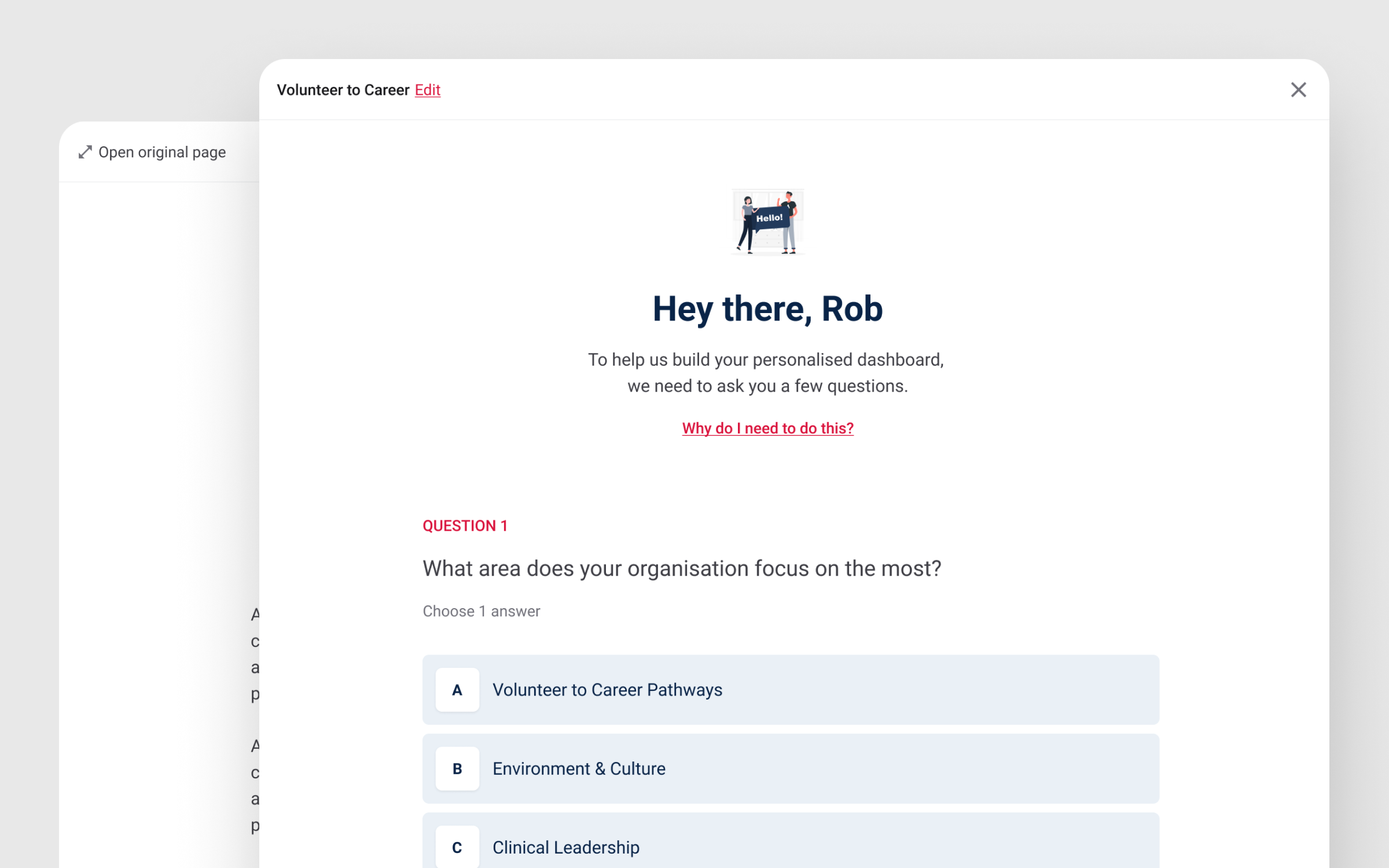

Rapid validation of a self-assessment tool for volunteers
We validated a new product idea that would assess the impact of volunteer services. Using a Design Sprint, we went from idea to validated product in 5 days.

Maximising volunteering impact
Helpforce wanted to help their clients improve their volunteering services. They would do this using personalised learning and self-assessment scoring. The idea was to create a 'Self Assessment Tool'. Volunteer Service Managers would answer assessments, which would allow Helpforce to gather data. They would use that data to provide curated learning and training resources. This would have a huge impact on the volunteering service.
But how would we encourage users to give quality data? And what would be the value for them? What would they get in return. The goal was clear but the team had a lot of questions and assumptions baked into their thinking.
To deliver value to clients and secure funding – this product needed validating.
So we decided to run a Design Sprint.


From idea to validation in 5 days
Helpforce and nuom collaborated together to run a Design Sprint. A 5 day process to rapidly uncover insights and test new ideas. To understand the challenges and test the assumptions, we needed to bring everyone together. Our team worked with HF project leads Max and Daz to download all the learnings they had. We mapped out all the challenges across a user journey. Then we were able to get a good understanding of what we needed to do. Within the first day of the Design Sprint, we aligned the team around the scope and goals of the product.
By the end of Day 2, we had created a storyboard of the full product. We built an interactive prototype on Day 3. We also looked at all the questions we needed to answer. Then we set out to figure them out during user testing.

Gathering insights from users
After identifying what to focus on, we sat down 1:1 with a range of clients and had them go through our prototype. We targeted clients who we know want to improve their services. We also aimed to understand what areas they thought were missing. As well as any ideas we hadn't considered.
Our assumption that "users would struggle to fill out the assessments" was false. Clients were happy to fill in the form if they saw a value for learning at the end. Also, we didn't consider creating an account to save and organise these learnings. 4/5 users tested said they would enjoy having their own space. One user commented that it would "create an invaluable learning tool".
Next Steps
Following the Design Sprint, we ran another 2 weeks of prototyping. Taking the feedback from users, we refined the product and fixed the issues that came up in testing. We crafted a multi-path prototype that was true to the vision of the product. Currently, Helpforce are getting funding from their board to build the MVP of this tool.
Like this? You'll love some of our other projects too
Rapid validation of a self-assessment tool for volunteers
We validated a new product idea that would assess the impact of volunteer services. Using a Design Sprint, we went from idea to validated product in 5 days.
Maximising volunteering impact
Helpforce wanted to help their clients improve their volunteering services. They would do this using personalised learning and self-assessment scoring. The idea was to create a 'Self Assessment Tool'. Volunteer Service Managers would answer assessments, which would allow Helpforce to gather data. They would use that data to provide curated learning and training resources. This would have a huge impact on the volunteering service.
But how would we encourage users to give quality data? And what would be the value for them? What would they get in return. The goal was clear but the team had a lot of questions and assumptions baked into their thinking.
To deliver value to clients and secure funding – this product needed validating.
So we decided to run a Design Sprint.



From idea to validation in 5 days
Helpforce and nuom collaborated together to run a Design Sprint. A 5 day process to rapidly uncover insights and test new ideas. To understand the challenges and test the assumptions, we needed to bring everyone together. Our team worked with HF project leads Max and Daz to download all the learnings they had. We mapped out all the challenges across a user journey. Then we were able to get a good understanding of what we needed to do. Within the first day of the Design Sprint, we aligned the team around the scope and goals of the product.
By the end of Day 2, we had created a storyboard of the full product. We built an interactive prototype on Day 3. We also looked at all the questions we needed to answer. Then we set out to figure them out during user testing.


Gathering insights from users
After identifying what to focus on, we sat down 1:1 with a range of clients and had them go through our prototype. We targeted clients who we know want to improve their services. We also aimed to understand what areas they thought were missing. As well as any ideas we hadn't considered.
Our assumption that "users would struggle to fill out the assessments" was false. Clients were happy to fill in the form if they saw a value for learning at the end. Also, we didn't consider creating an account to save and organise these learnings. 4/5 users tested said they would enjoy having their own space. One user commented that it would "create an invaluable learning tool".
Next Steps
Following the Design Sprint, we ran another 2 weeks of prototyping. Taking the feedback from users, we refined the product and fixed the issues that came up in testing. We crafted a multi-path prototype that was true to the vision of the product. Currently, Helpforce are getting funding from their board to build the MVP of this tool.






